2013-2014学年七年级英语上册 Unit 3 Body Parts and Feelings单元综合检测试题 (新版)冀教版
冀教版七年级上册英语Unit 3 单元知识点归纳
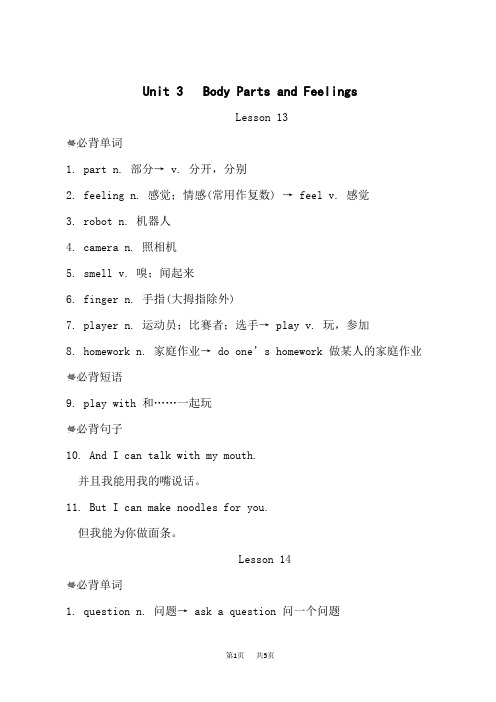
Unit 3 Body Parts and FeelingsLesson 13必背单词1. part n. 部分→ v. 分开,分别2. feeling n. 感觉;情感(常用作复数) → feel v. 感觉3. robot n. 机器人4. camera n. 照相机5. smell v. 嗅;闻起来6. finger n. 手指(大拇指除外)7. player n. 运动员;比赛者;选手→ play v. 玩,参加8. homework n. 家庭作业→ do one’s homework做某人的家庭作业必背短语9. play with 和……一起玩必背句子10. And I can talk with my mouth.并且我能用我的嘴说话。
11. But I can make noodles for you.但我能为你做面条。
Lesson 14必背单词1. question n. 问题→ ask a question 问一个问题2. sick adj. 病的;生病的→ ill 有病的; 生病的3. scared adj. 恐惧的→ be scared of sb./sth. 害怕某人或某物→ be scared to do sth. 害怕做某事4. smile v. & n. 微笑→ smile at sb. 向某人微笑5. mean adj. 不善良的;刻薄的& v. 意思是→ meaning n. 意思; 意义→ means n. 方法; 手段必背短语6. listen to 听……7. wave one’s hand 挥手8. see red 火冒三丈; 突然发怒必背句子9. In English, we use many colours for our feelings.在英语中,我们用许多颜色来表达我们的情感。
Lesson 15必背单词1. metre n. 米→kilometre 千米→centimetre 厘米2. bit n. 小量;少量3. against prep. 倚着,靠着;反对,违反→ play against...与……对抗; 与……比赛4. tail n. 尾部;尾巴5. upon prep. 在……上面6. ground n. 地面→ on the ground 在地面上必背短语7. stand up against 靠……站着必背句子8. She’s a bit short. 她有点儿矮。
冀教版-英语-七上-教案3单元 第13课 Body Parts
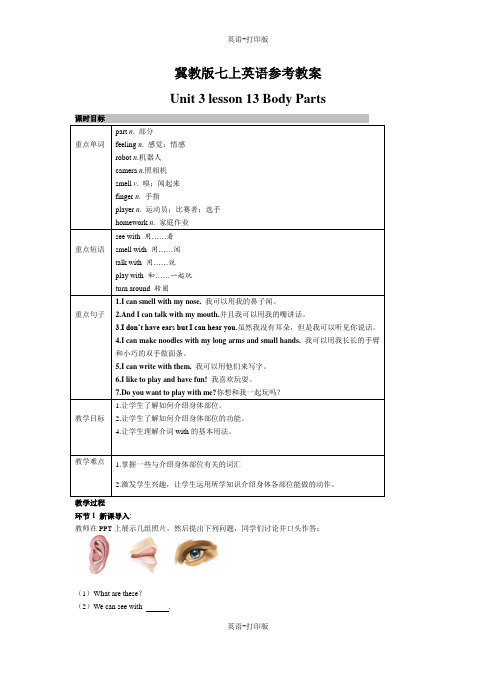
冀教版七上英语参考教案Unit 3 lesson 13 Body Parts 课时目标重点单词 part n . 部分 feeling n . 感觉;情感robot n .机器人camera n .照相机smell v . 嗅;闻起来finger n . 手指player n . 运动员;比赛者;选手homework n . 家庭作业重点短语 see with 用……看 smell with 用……闻talk with 用……说play with 和……一起玩turn around 转圈重点句子 1.I can smell with my nose. 我可以用我的鼻子闻。
2.And I can talk with my mouth.并且我可以用我的嘴讲话。
3.I don’t have ears but I can hear you.虽然我没有耳朵,但是我可以听见你说话。
4.I can make noodles with my long arms and small hands. 我可以用我长长的手臂和小巧的双手做面条。
5.I can write with them. 我可以用他们来写字。
6.I like to play and have fun! 我喜欢玩耍。
7.Do you want to play with me?你想和我一起玩吗?教学目标1.让学生了解如何介绍身体部位。
2.让学生了解如何介绍身体部位的功能。
4.让学生理解介词with 的基本用法。
教学难点 1.掌握一些与介绍身体部位有关的词汇2.激发学生兴趣,让学生运用所学知识介绍身体各部位能做的动作。
教学过程环节1 新课导入:教师在PPT 上展示几组照片,然后提出下列问题,同学们讨论并口头作答:(1)What are these ?(2)We can see with .(3)we can hear with .设计意图:通过图片展示更加直观地呈现本课时的主题:body parts。
【冀教版】七年级上册:Unit 3《Body Parts and Feelings》全单元教案【精校版】
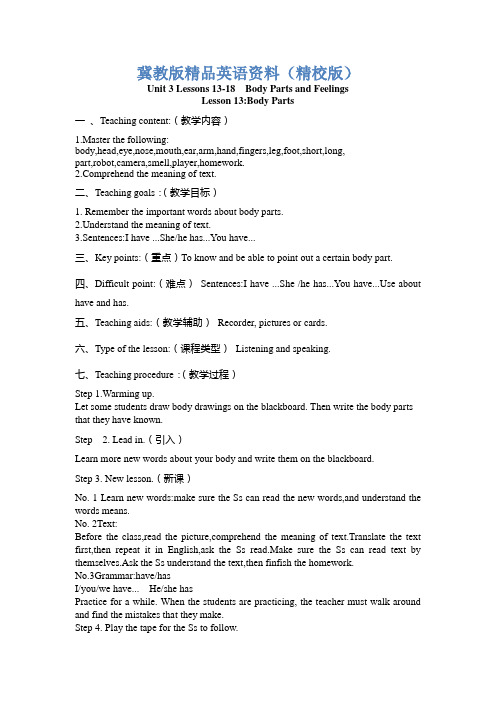
冀教版精品英语资料(精校版)Unit 3 Lessons 13-18 Body Parts and FeelingsLesson 13:Body Parts一、Teaching content:(教学内容)1.Master the following:body,head,eye,nose,mouth,ear,arm,hand,fingers,leg,foot,short,long,part,robot,camera,smell,player,homework.prehend the meaning of text.二、Teaching goals:(教学目标)1. Remember the important words about body parts.2.Understand the meaning of text.3.Sentences:I have ...She/he has...You have...三、Key points:(重点)To know and be able to point out a certain body part.四、Difficult point:(难点)Sentences:I have ...She /he has...You e about have and has.五、Teaching aids:(教学辅助)Recorder, pictures or cards.六、Type of the lesson:(课程类型)Listening and speaking.七、Teaching procedure:(教学过程)Step 1.Warming up.Let some students draw body drawings on the blackboard. Then write the body parts that they have known.Step 2. Lead in.(引入)Learn more new words about your body and write them on the blackboard.Step 3. New lesson.(新课)No. 1 Learn new words:make sure the Ss can read the new words,and understand the words means.No. 2Text:Before the class,read the picture,comprehend the meaning of text.Translate the text first,then repeat it in English,ask the Ss read.Make sure the Ss can read text by themselves.Ask the Ss understand the text,then finfish the homework.No.3Grammar:have/hasI/you/we have... He/she hasPractice for a while. When the students are practicing, the teacher must walk around and find the mistakes that they make.Step 4. Play the tape for the Ss to follow.Step 5.Summary. (小结)Sum up the body parts,distinction have and has how to use it.Step 6. Homework.(作业)Do your excise book.Step 7.Blackboard-writing:(板书)八.Teaching reflection:(教后反思)Lesson 14:Colors and Feelings一、Teaching content:(教学内容)1.To master these words:sad, sick, scared, angry. To understand the following:question.smile,mean.2. some useful patterns:How can you feel a color? Don't be scared!二、Teaching goals:(教学目标)1.to learn how to express the feelings .2.to learn more about the colors.3.to use what was learned in the daily life三、Key points:(重点)The words about feelings: sad, sick, scared, angry.四、Difficult point:(难点)What colors stand for what feelings.五、Teaching aids:(教学辅助)Recorder, pictures or cards.六、Type of the lesson:(课程类型)Listening and speaking.七、Teaching procedure:(教学过程)Step 1.Warming up.Review the words about colors.Step 2. Lead in.(引入)Ask the students questions in the life. You give a student a present and ask his feeling now. Then lead the words:happy, sad, sick, scared, angry.Step 3. New lesson.(新课)No. 1 I feel blue.Li Ming:Hi,Jenny!I am listening to an English song.In the song,the singer says "I feel blue".How can you feel a color?Jenny:That's a good questions.In English,we use many colors for our feelings.Blue can mean "sad".Green can mean "sick".Yellow can mean "scared".And red can mean "angry".Li Ming:Wow!Thank you,Jenny.In China,red is a happy color.No. 2 Sentences:Don't feel bad.Don't be scared.Don't see red.Don't feel sick.Step 4. Play the tape for the Ss to follow.Step 5.Summary. (小结)Sum up the words about feelings,and what colors for what feelings.Step 6. Homework.(作业)Finish the activity book.Step 7.Blackboard-writing:(板书)The words about feelings.八.Teaching reflection:(教后反思)Lesson 15:Tall or Short一、Teaching content:(教学内容)1.master these new words: tall,short.2.to understand these words: Meter, stand, on3. the in-structures : How tall are you? I’m 1.6 meters tall.二、Teaching goals:(教学目标)1.to be able to ask about one’s hight.2.ask the students to do active practice3.Sentences:How tall are you? How tall is she/he?三、Key points:(重点)1.how to say one’s height in English.2.to be able to read the text in the correct tones with the perfect pronunciation.四、Difficult point:(难点)How to read out “3.1 meters , 1.6 meters”. (plural forms of nouns)五、Teaching aids:(教学辅助)Recorder, pictures or cards.六、Type of the lesson:(课程类型)Listening and speaking.七、Teaching procedure:(教学过程)Step 1.Warming up.Learn new word:tall,short,meter,stand ,against,tail,flat,upon,ground.Step 2. Lead in.(引入)Introduce the text first in Chinese,then ask the Ss read the pictures,answer the questions.Step 3. New lesson.(新课)No. 1 Presentationa ruler or some other things while can be used to measure the length, the height, and so on.No. 2 Practice telling one heightAsk the students :1. How tall are you?2. How tall is she/he?3. How tall is your teacher?4. How tall is your friend?Talk about the partner about the subject. Then ask volunteers to come to the front to act the dialogue out.Step 4. Play the tape for the Ss to follow.Step 5.Summary. (小结)Practice the dialogue . Let some students act it out.Step 6. Homework.(作业)Finish the activity book.Step 7.Blackboard-writing:(板书)The important words.八.Teaching reflection:(教后反思)Lesson 16:Happy or Sad一、Teaching content:(教学内容)1.To master these words:happy, sad.To understand the following:very, tired,enough.2. some useful patterns:How do you feel? I feel happy! I’m NOT fine, thanks. Are you tired? No, I’m not. I just feel sad.二、Teaching goals:(教学目标)1.to learn how to express the feeling of sad and happy.2.to learn more about the feelings.3.to use what was learned in the daily life.三、Key points:(重点)How do you feel? I feel happy! I’m NOT fine, thanks. Are you tired? No, I’m not. I just feel sad.四、Difficult point:(难点)Practice the dialogue.五、Teaching aids:(教学辅助)Recorder, pictures or cards.六、Type of the lesson:(课程类型)Listening and speaking.七、Teaching procedure:(教学过程)Step 1.Warming up.Ask the students questions in the life. You give a student a present and ask his feeling now. Then lead the words: happy, sad.Step 2. Lead in.(引入)Before the class,make the Ss understand the followingquestions:1.How does Jenny feel?2.Is Danny hurt?3.Is Danny tired?Step 3. New lesson.(新课)No. 1 Give the presents that you prepared to the s tudents that do well. Then ask “How do you feel?” Explain it in Chinese when it is necessary. Help them answer “I’m happy.” Then take their presents away and ask “How do you feel now?” Help them answer “I’m sad”No. 2Begin “happy, sad” game in pairs, using the presents that we prepared before the class. The best one will get a present.Let’s sing a song together. Listen to the tape and sing happily after it. Encourage students to sing loudly because what we need is a happy feeling. The students can stand up and do according to the text.Step 4. Play the tape for the Ss to follow.Step 5.Summary. (小结)Sum up sentences:How do you feel?Step 6. Homework.(作业)Finish the activity book.Step 7.Blackboard-writing:(板书)八.Teaching reflection:(教后反思)Lesson 17:Seeing a Doctor一、Teaching content:(教学内容)Master these new words and expressions: How do you feel? hurt,stomachache,headache,medicine,have a good rest,see a doctor,have a cold,what's the matter?二、Teaching goals:(教学目标)1.Encourage students to express the uncomfortable feeling.2.Practice the sentences go on:How do you feel? What’s the matter?3.Understand the meaning of text and practice the dialogue.三、Key points:(重点)Help students grasp the expressions to ask and answer the uncomfortable feeling. 四、Difficult point:(难点)Learn the key sentence: What’s the matter? ___ hurt(s). I have a -ache.五、Teaching aids:(教学辅助)Recorder, pictures or cards.六、Type of the lesson:(课程类型)Listening and speaking.七、Teaching procedure:(教学过程)Step 1.Warming up.Let some students draw body drawings on the blackboard. Then write the body parts that they have known.Step 2. Lead in.(引入)Learn more new words about your body and write them on the blackboard.Step 3. New lesson.(新课)No. 1 PresentationListen and repeat the new words. Because some words are hard, we listen and repeat for several times until we can read the words correctly.Point to parts of your body as you and the class say the words.No. 2 Dialogue:1 Are you OK?Jenny:How do you feel,Jim? Are you OK?Jim:See my arm?It hurts.Jenny:It looks bad!Let's go and see a doctor.2.You have a cold.Dr.Green:Hi,Danny.What's the matter?Danny:I feel sick.I have a headache.Dr.Green:Do you feel cold?Danny:Yes!I feel very cold.Dr.Green:Well,let me see...You have a cold.Take this medicine.Stay home and have a good rest.Danny:OK.Thank you ,Doctor Green.Step 4. Play the tape for the Ss to follow.Step 5.Summary. (小结)Sum up the phrases:How do you feel? have a good rest,see a doctor,have a cold,what's the matter?You'd better...Step 6. Homework.(作业)Finish the activity book.Step 7.Blackboard-writing:(板书)The useful phrase.八.Teaching reflection:(教后反思)Lesson 18:We All Look Different一、Teaching content:(教学内容)1.master these new words:hair, has.2.learn and understand these words:different,blond.eful instructions : What does he/she look like? She /he has long/short hair. I have short hair.二、Teaching goals:(教学目标)1.learn to describe the looking of oneself and other students.2.to be able to read the text fluently.3.to write a short passage in English, describe oneself or other people.三、Key points:(重点)How to describe one’s hair, including the length and the color.四、Difficult point:(难点)The verb should be in a special form, such as have and has.五、Teaching aids:(教学辅助)Recorder, pictures or cards.六、Type of the lesson:(课程类型)Listening and speaking.七、Teaching procedure:(教学过程)Step 1.Warming up.Review: Express the feelings of yourself. You can say like this: Are you OK? How do you feel? Let some students answer and ask questions like this.Step 2. Lead in.(引入)Introduce the text in Chinese first.Learn to describe the looking of oneself and other students.Step 3. New lesson.(新课)No. 1 What does he/she look like?(describe people)She is beautiful.He is good-looking.He looks cool!She looks cute!No. 2 We all look different.(have/has)She has short blond hair.He has three black hair.I have short black hair.Step 4. Play the tape for the Ss to follow.Step 5.Summary. (小结)Sentences: What does he/she look like? She /he has long/short hair. I have short hair.Step 6. Homework.(作业)Come to the activity book.Step 7.Blackboard-writing:(板书)The master words.八.Teaching reflection:(教后反思)Unit Review一、Teaching content:(教学内容)1.Words and phrases .2.Key sentences .二、Teaching goals:(教学目标)1. Enable students to use the words and the expressions learned freely.2.Help students grasp the expressions in their daily life.三、Key points:(重点)The words and the expressions in this unit.四、Difficult point:(难点)How to use “have” and “has”.五、Teaching aids:(教学辅助)Recorder, pictures or cards.六、Type of the lesson:(课程类型)Review.七、Teaching procedure:(教学过程)Step 1.Warming up.Review words and expressions in this unit .Step 2. Task:No. 1 Building your vocabulary.Finish the excise on page 46 for remembering more word.No. 2 Grammar in use.(have/has)Practice:Fill in the blanks with have/has.1.May I a pencil,Jenny?2.Danny many yellow shirts.3.You a cold.You'd better go and see a doctor.4.She feels sick.She a stomachache.Step 3. Play the tape for the Ss to follow.Then finish the homework.Step 4.Summary. (小结)Sum up the phrases:play with,listen to,wave one's hand,see red,How tall is she/he? How tall are you? a bit,How do you feel?What's wrong?What's the matter?See a doctor.Are you OK? I have a headache.You'd better ... Have a cold.stay home.have a rest. What does he/she look like? Look different.look cool/cute/funny.Step 5. Homework.(作业)Finish the excises book.Step 6.Blackboard-writing:(板书)Grammar.八.Teaching reflection:(教后反思)。
冀教版英语七年级上册Unit 3 Body Parts and Feelings 重难点知识归纳总结

Unit 3 Body Parts and Feelings【重点单词】1.part /pɑːt/ n. 部分2.feeling /ˈfiːlɪŋ/ n. 感觉;情感(常用作复数)3.robot /ˈrəʊbɒt/ n. 机器人4.camera /ˈkæmrə/ n. 照相机5.smell /smel/ v. 嗅;闻起来6.finger /ˈfɪŋɡə(r)/ n. 手指(大拇指除外)7.player /ˈpleɪə(r)/ n. 比赛者;选手8.homework /ˈhəʊmwɜːk/ n. 家庭作业9.singer /ˈsɪŋə(r)/ n. 歌手10.question /ˈkwestʃən/ n. 问题11.sick /sɪk/ adj. 病的;生病的12.scared /skeəd/ adj. 恐惧的13.smile /smaɪl/ v. 微笑14.wave /weɪv/ v. & n. 挥手;招手15.mean /miːn/ v. 意思是adj. 刻薄的16.metre /'mi:tə(r)/ n. 米17.bit /bɪt/ n. 小量;少量18.against /əˈɡenst; əˈɡeɪnst/ prep. 倚着,靠着;反对,违反19.tail /teɪl/ n. 尾部;尾巴20.flat /flæt/ adv. 水平地21.upon /əˈpɒn/ prep. 在……上面22.ground /ɡraʊnd/ n. 地面23.hurt /hɜːt/ adj. 痛的;受伤的v. 伤害;疼痛24.donut /ˈdəʊnʌt/ n. 面包圈25.enough /ɪˈnʌf/ adj.& adv. 足够的(地)ugh /lɑːf/ v. 笑27.stomachache /'stʌməkeɪk/ n. 肚子痛;胃痛28.better /ˈbetə(r)/ adj.& adv. (good/well的比较级)更好的(地)29.matter /ˈmætə(r)/ n. 问题30.headache /ˈhedeɪk/ n. 头痛31.medicine /ˈmedsn/ n. 药32.stay /steɪ/ v. 停留;留下;待一段时间33.rest /rest/ n.&v. 休息34.different /ˈdɪfrənt/ adj. 不同的35.cute /kjuːt/ adj. 逗人喜爱的;漂亮的36.twelve /twelv/ num. 十二37.blond /blɒnd/ adj.&n. 金色(的);浅黄色(的)38.thirteen /ˌθɜːˈtiːn/ num. 十三39.almost /ˈɔːlməʊst/ adv. 几乎;差不多40.funny /ˈfʌni/ adj. 有趣的;可笑的41.glass /ɡlɑːs/ n. 眼镜(glasses);玻璃,玻璃杯【重点短语】1.play with 和……一起玩2.listen to 听3.wave one’s hand 挥手4.a bit 有一点5.stand against/upon 靠着……站6.see a doctor 看医生7.You’d better... 你最好……8.What’s wrong? 怎么了?9.feel sick 感到不舒服10.have a headache 头痛11.have a cold 感冒12.take medicine 吃药13.stay home 待在家里14.have a rest 休息【重点句型】1.Do you want to play with me? 你想和我一起玩吗?2.Can you do my homework for me, Robin? 你能帮我做作业吗,罗宾?3.Sorry, I can’t do your homework, but I can make noodles for you. 对不起,我不能做你的家庭作业,但是我可以给你做面条。
冀教版七年级英语上册《nit 3 Body Parts and Feelings Lesson 15 Tall or Short》优质课教案_1
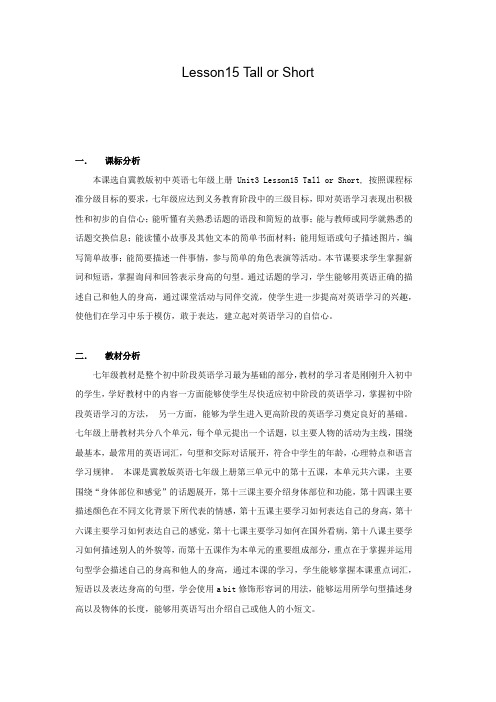
Lesson15 Tall or Short一.课标分析本课选自冀教版初中英语七年级上册Unit3 Lesson15 Tall or Short, 按照课程标准分级目标的要求,七年级应达到义务教育阶段中的三级目标,即对英语学习表现出积极性和初步的自信心;能听懂有关熟悉话题的语段和简短的故事;能与教师或同学就熟悉的话题交换信息;能读懂小故事及其他文本的简单书面材料;能用短语或句子描述图片,编写简单故事;能简要描述一件事情,参与简单的角色表演等活动。
本节课要求学生掌握新词和短语,掌握询问和回答表示身高的句型。
通过话题的学习,学生能够用英语正确的描述自己和他人的身高,通过课堂活动与同伴交流,使学生进一步提高对英语学习的兴趣,使他们在学习中乐于模仿,敢于表达,建立起对英语学习的自信心。
二.教材分析七年级教材是整个初中阶段英语学习最为基础的部分,教材的学习者是刚刚升入初中的学生,学好教材中的内容一方面能够使学生尽快适应初中阶段的英语学习,掌握初中阶段英语学习的方法,另一方面,能够为学生进入更高阶段的英语学习奠定良好的基础。
七年级上册教材共分八个单元,每个单元提出一个话题,以主要人物的活动为主线,围绕最基本,最常用的英语词汇,句型和交际对话展开,符合中学生的年龄,心理特点和语言学习规律。
本课是冀教版英语七年级上册第三单元中的第十五课,本单元共六课,主要围绕“身体部位和感觉”的话题展开,第十三课主要介绍身体部位和功能,第十四课主要描述颜色在不同文化背景下所代表的情感,第十五课主要学习如何表达自己的身高,第十六课主要学习如何表达自己的感觉,第十七课主要学习如何在国外看病,第十八课主要学习如何描述别人的外貌等,而第十五课作为本单元的重要组成部分,重点在于掌握并运用句型学会描述自己的身高和他人的身高,通过本课的学习,学生能够掌握本课重点词汇,短语以及表达身高的句型,学会使用a bit修饰形容词的用法,能够运用所学句型描述身高以及物体的长度,能够用英语写出介绍自己或他人的小短文。
七年级英语上册Unit3BodyPartsandFeelings语法聚焦三
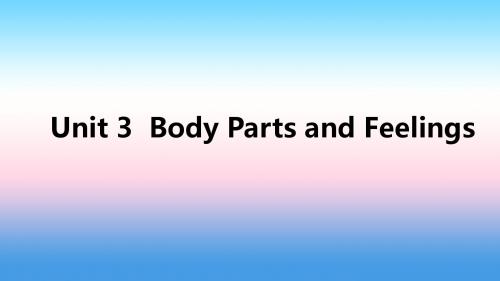
我有两条长腿和两只大脚。
单元语法聚焦三
4. I'm 1.65 metres tall. 我身高1.65米。 以上四个句子中都用了名词的复数形式。你知道名词的复数
形式有哪些吗?下面就让我们一起探讨一下吧。
通过观察教材上的这三个句子,我们可以看出,表示“某人拥 有某物”时,我们通常会用到动词have。 关于它的用法,你了解多 少呢?
单元语法聚焦三
语法探究
实义动词have
句式
用法
肯定句
I/You/We/They have… He/She/It has…
Do I/you/we/they have…? 一般疑问句
单元语法聚焦三
2.单数与复数同形的名词 初中英语中,单数和复数同形的名词主要有sheep(绵羊), fish(鱼),deer(鹿),Chinese(中国人),Japanese(日本人), Swiss(瑞士人)等。 注意:fish 有时也用 fishes,这样的复数形式尤其表示种类。
单元语法聚焦三
单元语法聚焦三
(3)以-y 结尾的名词,其复数构成要分两种情况:以“辅音字母+ y”结尾的名词,将y变为i,再加-es;以“元音字母+y”结尾的名 词,直接在词尾加-s。例如: city→cities(城市); boy→boys(男孩); key→keys(钥匙)
单元语法聚焦三
(4)以-o结尾的名词,有些在词尾加-s,有些在词尾加-es。例如: piano→pianos(钢琴); tomato→tomatoes(西红柿) 注意:初中英语中,以-o结尾的名词词尾后加-s构成复数名词的 有 zoo(动物园),photo(照片),piano (钢琴);词尾加-es的有 tomato(西红柿),potato(土豆),hero(英雄)。
最新冀教版七年级英语上册单元知识点Unit3

冀教版七年级英语上册单元知识点Unit3Lesson 13 Body parts1.words: eye 眼睛nose 鼻子mouth 嘴ear 耳朵hand 手arm 手臂finger 手指foot(feet)脚leg 腿2.I can see with them.我能用它们看东西. with 用…I can smell with my nose. 我用鼻子闻.I can talk with my mouth. 我用嘴谈话.3.I can speak English and Chinese. 我会说英语和汉语. speak 说(说语言)4.Just like you. 像你一样. make noodles 做面条5.play v.玩;运动player n.运动员sing v.唱歌singer n.歌手6. do one’s homework 做作业(其中one’s跟随主语变成相应的形容词性物主代词)He does his homework every day.I do my homework at school.Lesson 14 Colours and feelings.1.I am listening to an English song. 我正在听一首英文歌.be(am/is/are) doing…正在做某事(现在进行时be+动词ing)2.We use many colours for our feelings. 我们用很多颜色来表示情感. use…for….=use….to do …用…来做….3.Don’t+动词原形…不要做某事(否定的祈使句)Don’t be+形容词. 别…Don’t cry. 别哭. Don’t laugh at others. 别嘲笑他人.Don’t be scared. 别害怕. Don’t be angry. 别生气. Don’t be sad. 别伤心.4.I am sick.=I don’t feel well. 我感觉不舒服.5.What does the word mean?=What is the meaning of the word?这个单词什么意思?6.shake hands 握手wave the hand 挥挥手in English 在英语中;用英语in the song 在歌曲中Lesson 15 Tall or short1.How tall is he? He is 1.65 metres tall. 他多高?他1.65米高.How tall 多高(提问身高) 1.65 one point six five除1米用metre,其余都用metres2.She is a bit short. 她有点儿矮.a bit=a little=kind of 有点儿(修饰形容词表示程度)3.stand up 站立;起立against the wall 靠墙upon the ground 在地上Lesson16 Happy or sad.1.What’s wrong?=What’s the matter? 怎么啦?What’s wrong with you? 你怎么啦?2.My mum wants me to eat just one donut a day.我妈妈想让我一天只吃一个面包圈.want sb. to do sth. 想让某人做某事want to do sth.想做某事3.反义词或对应词small 小的----big 大的long 长的---short 短的tall 高的----short 矮的high 高的---low 低的happy 高兴的----sad 悲伤的cry 哭---laugh 笑up 上----down 下new 新的---old 旧的young 年轻的---old 年老的clean 干净的----dirty 脏的man 男人---woman 女人girl 女孩---boy 男孩brother 兄弟---sister 姐妹uncle 叔叔---aunt 阿姨4.同音词son 太阳---sun儿子eye眼睛---I 我right 对的---write 写too 也---two 二Lesson 17 Seeing a doctor1.Let’s go and see a doctor. 让我们去看医生.(let之后动词用原形)Let me see. 让我看一看.2.You’d better go and see a doctor. 你最好去看医生.(You’d better 之后动词用原形)3.have a +疾病have a headache 头疼have a fever 发烧have a stomachache 胃疼have a cold 感冒have a toothache 牙疼4.take this medicine 服药stay home=stay at home 呆在家里have a good rest 好好休息一下Lesson 18 We all look different詹妮来自加拿大.2.She is twelve years old. (划线提问)How ole is she?How old 多少岁(提问年龄)3.How many+名词复数….?多少….? 提问可数名词的数量There are sixty students in our class.(划线提问)How many students are there in your class?Danny has three hairs.(划线提问) How many hairs does Danny have?4.a pair of glasses 一副眼镜 a pair of shoes 一双鞋a pair of socks 一双袜子 a pair of pants 一条裤子a pair of shorts 一条短裤 a pair of gloves 一双手套5.look different 看起来不一样look the same 看起来一样They look different.(同义句) They don’t look the same.6.What do/does…look like? …长什么样?(提问外貌、体型…)She is beautiful.(划线提问) What does she look like? 她长什么样?Danny is big and tall.(划线提问) What does Danny look like?。
七年级英语上册 Unit 3 Body Parts and Feelings Lesson 16 Happy or Sad预习课件 (新版)冀教版
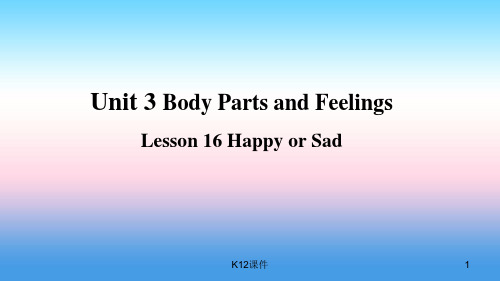
K12课件
8
自主学习要求
学习以上内容,认真完成 1、预习案上的习题 2、老师布置的讨论作业 你能用英语说出多少种问候他人的方法。
K12课件
9
12课件
5
◆ What's wrong? 怎么了?
此句是一个固定句型,用来询问对方的情况,表示对对方的关
心,也是医生、护士询问病人的常用语。句型
“What's the matter?”与其含义相同,回答不用yes或no,应根
据具体情况回答。
-What's wrong with you? 你怎么了?
K12课件
2
阅读课文找出下列短语 1.你觉得.....__H__o_w__d_o_y_o_u__fe_e_l___ 2.出什么事了?_W__h_a_t’_s_w__ro_n_g_?__ 3.你累了吗?__A_r_e_y_o_u__ti_re_d_?_ 4.感到很悲伤___f_e_e_l_s_a_d_ 5.一天一个甜甜圈够了__O_n_e_d_o_n_u_t__a_d_a_y_i_s_e_n_o_u_g_h_
-I'm hurt. 我受伤了。
【拓展】如要说明对象,其后可接with sb. /sth. ,表示“某人
/某物出什么事了”。
What's wrong with your handK?1你2课的件手怎么了?
6
◆ hurt adj. (身体上或感情上) 受伤的 v. (使)疼痛,受伤 Is your leg still hurt? (形容词) 你的腿还疼吗? My arm hurts. (动词) 我的胳膊疼。 ◆ enough adj. & adv. 足够的 (地) enough修饰名词时,应放在名词之前;enough修饰形容词或 副词时,应放在形容词或副词之后。
冀教版 英语七年级上册 Unit 3 Body Parts and Feelings单元练习 (含答

冀教版英语七年级上册Unit 3 Body Parts and Feelings单元练习(含答案)冀教版英语七年级上册单元练习Unit 3(含答案)一、单项选择1.(2023吉林长春)—The Changchun subway will be in use. will it take you to get to school on it—Only ten minutes.It’ll be quick and convenient.A.How much B.How manyC.How often D.How long2.— Won’t he take care of his pet when his parents are out— ____________. He’s too young.A.Yes, he will B.Yes, he won’tC.No, he will D.No, he won’t3.— Why does she keep ________ my love for her— Maybe you should spend more time with her and tell her your love! A.fighting B.questioning C.complaining D.discussing4.Don’t __________Chinese in an English class.A.speak B.say C.talk D.tell5.My favourite food_______ dumplings and rice.A.are B.have C.has D.is二、补全对话单选Bill: Hi, Jim! Are you in a new school nowJim: Yes.Bill:Jim: Yes. But there are lots of rules.Bill: ReallyJim: We must be on time. We can’t wear a hat in the classroom.Bill:Jim: No, we can’t. We can’t eat in the hallways, either.Bill: Do you have to wear school uniformsJim: Yes.Bill: Oh, so many rules!6.A.Is that your friend B.Do you like itC.Do you have a sister D.Is she exercising7.A.What are the rules B.What time do you goC.Where are the maps D.How long does it take8.A.I’m very busy. B.You are late.C.They’re eating. D.We can’t fight.9.A.Can you play the drums B.Can you eat in the classroom C.Are you eating breakfast D.Are you good at playing soccer 10.A.We usually take the bus to school. B.I like to play with my friends. C.We must wear them on school days. D.I never do the dishes afterdinner.三、完形填空先通读短文、掌握其大意,然后从A、B、C、D四个选项中选出一个可以填入相应空白处的最佳答案、并在答题卡上将该项涂黑。
冀教版七年级上册英语《Body Parts》Body Parts and Feelings
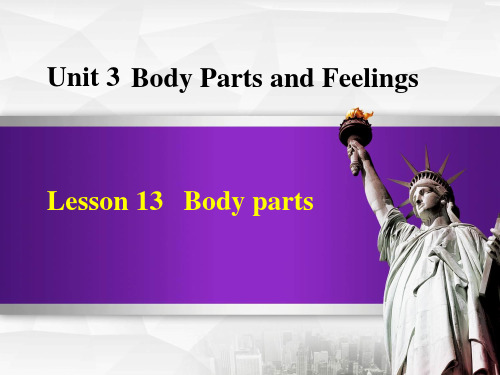
(2)play with sth.玩耍某物
eg:Don't play with water.不要玩水。
Let's Do It !
1) Listen and fill in the blanks. 1. I have two big __e_y_e_s__. I can__s_e_e__ with them. 2. I have one nose and one__m__o_u_th__. 3. I don't have___e_a_r_s__ but I can___h_e_a_r__ you. 4. I can make noodles with my long arms and __s_m__a_ll__
教案下载:/jiaoan/
PPT论坛:
PPT课件:/kejian/
语文课件:/kejian/yuw en/ 数学课件:/kejian/shuxue/
英语课件:/kejian/ying yu/ 美术课件:/kejian/me ishu/
I have two big eyes❶. I can see with them. They are also my cameras.
I have one nose and one mouth. I can smell ❷ with my nose. And I can talk with ❸ my mouth. I can speak English and Chinese!
PPT素材:/sucai/
PPT背景:/beijing/
冀教版初中英语七年级上册Unit 3 Body Parts and Feelings (教案)
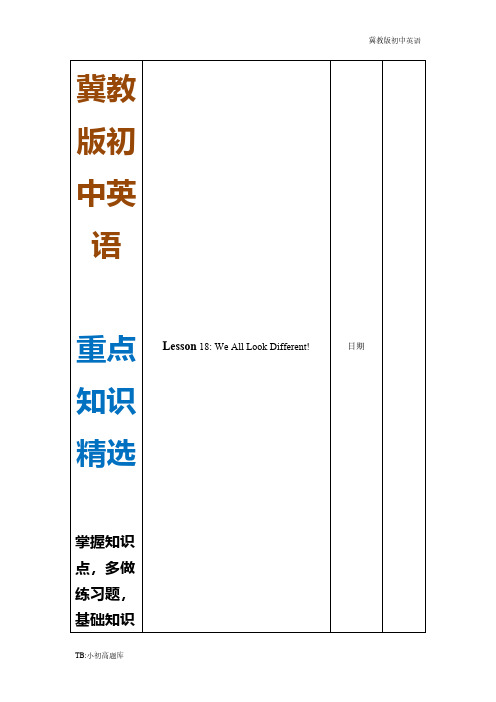
课后反思与重建
TB:小初高题库
冀教版初中英语
相信自己,就能走向成功的第一步 教师不光要传授知识,还要告诉学生学会生活。数学思维
可以让他们更理性地看待人生
TB:小初高题库
了解如何描述一个人的外貌特征。
TB:小初高题库
冀教版初中英语
重点难点
会准确使用 have, has 及多个形容词的排列顺序。
教学时数
2
教学方法 自主学习及合作学习
教学准备
Teaching Preparation: audiotape, flashcards,
教学过程: Step1.Greet each other before the class. Step2 知识超市 1. What does he/she look like?他/她看起来怎么样?
Step7. Homework
1. Finish the exercises on Page45.
2. Finish the exercises in. Unit Review.
板书设计
1. good-looking
2. short blond hair 3. big and tall 4. a pretty girl 5. wear glasses 6 look different
Step3. 合作探究 1.请听课文的录音两遍,根据课文内容填空。
Jenny is from Canada. She is twelve years old. She has short blond hair. Her eyes are blue. She is a pretty girl. Danny is from Canada. He is thirteen years old. He has three black hairs. He is big and tall. He looks funny. I have short black hair. I wear glasses. We all look different. Step4. 请仔细阅读课文,独立完成课本 P45 上第 2 部分的练习题。 Step 5 想一想 1. look different 的反义词是什么,其中 look 是什么词? 2. almost 和 nearly 都是“几乎”的意思,他们的用法一样吗 3. all 这个词在句子放在什么位置?
冀教版英语七上Unit3BodyPartsandFeelingsLesson14Coloursand

Languagg to an English song. listen“听”,为不及物动词,后面接宾语 时需要加介词to,强调动作。 e.g. I learn English by listening to cassettes.
Language points
Let’s review!
ear
face
arm
hand
Look and write. leg
head nose mouth
foot
Watch and learn
New words and expression.
singer n. 歌手 question n. 问题 sick adj. 病的;生病的 scared adj. 恐惧的 smile n. & v. 微笑 wave v. 挥手;招手 mean v. 意思是 adj. 刻薄的
Words Game 测测你的记忆力吧!
歌手 (n.) 问题 (n.) 病的,生病的 (adj.) 恐惧的 (adj.) 微笑 (v.) 挥手,招手 (v.) 意思是(v.);刻薄的(adj.)
冀教版七年级上册英语笔记
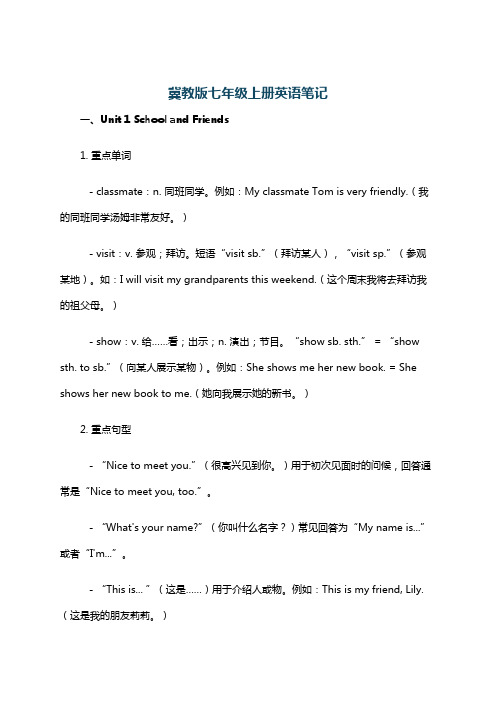
冀教版七年级上册英语笔记一、Unit 1 School and Friends1. 重点单词- classmate:n. 同班同学。
例如:My classmate Tom is very friendly.(我的同班同学汤姆非常友好。
)- visit:v. 参观;拜访。
短语“visit sb.”(拜访某人),“visit sp.”(参观某地)。
如:I will visit my grandparents this weekend.(这个周末我将去拜访我的祖父母。
)- show:v. 给……看;出示;n. 演出;节目。
“show sb. sth.” = “show sth. to sb.”(向某人展示某物)。
例如:She shows me her new book. = She shows her new book to me.(她向我展示她的新书。
)2. 重点句型- “Nice to meet you.”(很高兴见到你。
)用于初次见面时的问候,回答通常是“Nice to meet you, too.”。
- “What's your name?”(你叫什么名字?)常见回答为“My name is...”或者“I'm...”。
- “This is... ”(这是……)用于介绍人或物。
例如:This is my friend, Lily.(这是我的朋友莉莉。
)3. 语法- 一般现在时:- 概念:表示经常发生的动作或存在的状态。
- 结构:- 主语为第三人称单数(he/she/it等)时,动词要用第三人称单数形式(一般在动词原形后加 -s或 -es)。
例如:He likes reading books.(他喜欢读书。
) - 主语为第一人称(I)、第二人称(you)、复数(we/they等)时,动词用原形。
如:We play football after school.(我们放学后踢足球。
)二、Unit 2 Colours and Clothes1. 重点单词- colour:n. 颜色。
【冀教版】七年级上册:Unit 3《Body Parts and Feelings》(Lessons 13-15)课文重点整理(精修版)
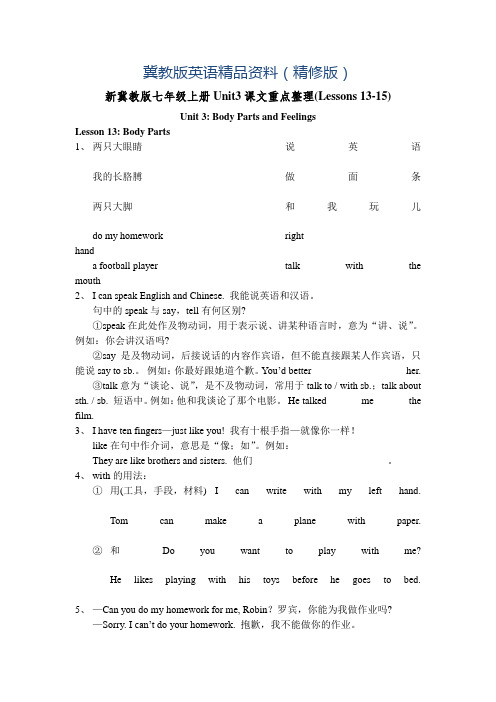
冀教版英语精品资料(精修版)新冀教版七年级上册Unit3课文重点整理(Lessons 13-15)Unit 3: Body Parts and FeelingsLesson 13: Body Parts1、两只大眼睛____________________ 说英语________________________我的长胳膊____________________ 做面条________________________两只大脚______________________ 和我玩儿______________________do my homework________________ righthand______________________a football player_________________ talk with the mouth_______________2、 I can speak English and Chinese. 我能说英语和汉语。
句中的speak与say,tell有何区别?①speak在此处作及物动词,用于表示说、讲某种语言时,意为“讲、说”。
例如:你会讲汉语吗? ______________________________②say是及物动词,后接说话的内容作宾语,但不能直接跟某人作宾语,只能说say to sb.。
例如:你最好跟她道个歉。
You’d better __________________ her.③talk意为“谈论、说”,是不及物动词,常用于talk to / with sb.;talk about sth. / sb. 短语中。
例如:他和我谈论了那个电影。
He talked ______ me ______ the film.3、 I have ten fingers—just like you! 我有十根手指—就像你一样!like在句中作介词,意思是“像;如”。
七年级英语上册 Unit 3 Body Parts and Feelings Lesson 16 Happy or Sad教案 (新版)冀教版
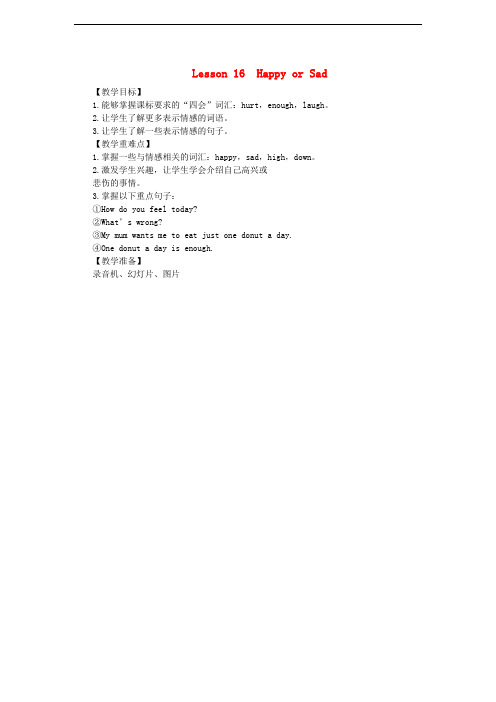
2.Who is right,Danny or his mother?
Finish the task in class orally.
Step 4:Practice
Ask the students to make up a dialogue to introduce feelings and tell the reasons.
1.Jenny feels________.
2.Danny’s mother wants him to eat________a day.
Finish the task in class orally.
Step 3:Reading
Read the lesson and answer the following questions:
一、创设情境,切入主题
Step 1:Lead-in
Lead-in by discussing the following question:
Why do you feel happy or sad?
Discuss in groups for three minutes.Then let some students present their answers in front of the class.
One donut a day is enough.
Step 5:Come to“Let’s Do It!”
Read the lesson again,and ask the students to finish Exercise 1.Listen to the tape and finish Exercise 2 together.
英语七年级上册冀教版 Lesson 13 Body Parts (共17张PPT)-经典教学教辅文档

图库用法指导
1、此图标库在色彩方面大致分为鲜亮色(符号及元素)和沉稳 色(各终端及实物场景),使用时,注意鲜亮色和沉稳色要 平衡,画面不要全是鲜亮色或者全是沉稳色。
2、由于各终端及实物场景的颜色是沉稳色,所以连接它们 的组网线要粗一些、颜色可以鲜一些,以产生对比,求 得视觉平衡。
3、这些图标大部分都有一定的透视,如果您注意其透视的 一致性,再加以有透视感的组网线,可以画出一张立体 的组网图。
Strike while the iron is hot.(趁热打铁)
1. Respect(尊重) is a very important _____of any
part
relationship(关系).
2. Yao Ming is one of my favourite basketball ______.
small
player
Read and Say.
This is a robot. His name is Robin. He has … He can …with his ...
Label Shrek’s body parts. nose
mouth
ear eyes
arm
leg
foot (复数feet)
robot ['rəubɔt] n. 机器人 camera ['kæmərə] n. 照相机
smell [smel] v. 嗅;闻起来 finger ['fiŋɡə] n. 手指(大拇指除外)
player ['pleɪə(r)] n. 比赛者;选手
homework ['həumwə:k] n. 家庭作业(不可数名词)
Listen to the song Hokey Pokey and do the actions.
七年级英语上册Unit3BodyPartsandFeelings主题写作三课件新版冀教版
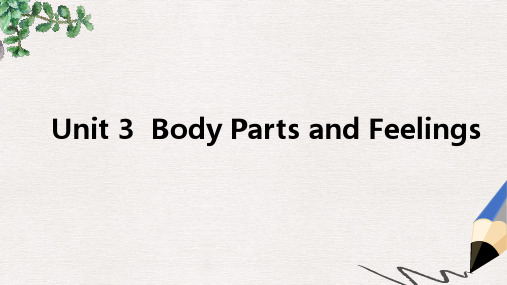
编后语
做笔记不是要将所有东西都写下,我们需要的只是“详略得当“的笔记。做笔记究竟应该完整到什么程度,才能算必录;最略则廖廖数笔,提纲挈领。做笔记的详略要依下面这些条件而定。
讲课内容——对实际材料的讲解课可能需要做大量的笔记。 最讲授的主题是否熟悉——越不熟悉的学科,笔记就越需要完整。 所讲授的知识材料在教科书或别的书刊上是否能够很容易看到——如果很难从别的来源得到这些知识,那么就必须做完整的笔记。 有的同学一味追求课堂笔记做得“漂亮”,把主要精力放在做笔记上,常常为看不清黑板上一个字或一句话,不断向四周同学询问。特意把笔记做得很
单元主题写作三
One possible version:
My Friend I have a good friend in my class. Her name is Lingling. She is a happy girl. Lingling is 1.5 metres tall. She is not very tall, but she looks beautiful. She has big black eyes, a small nose and a small mouth. She has long black hair. She likes wearing a blue sweater. She looks nice in it. Lingling and I are different, but we are good friends. Do you like her?
全的人,主要是担心漏掉重要内容,影响以后的复习与思考.,这样不仅失去了做笔记的意义,也将课堂“听”与“记”的关系本末倒置了﹙太忙于记录, 便无暇紧跟老师的思路﹚。 如果只是零星记下一些突出的短语或使你感兴趣的内容,那你的笔记就可能显得有些凌乱。 做提纲式笔记因不是自始至终全都埋头做笔记,故可在听课时把时间更多地用于理解所听到的内容.事实上,理解正是做好提纲式笔记的关键。 课堂笔记要注意这五种方法:一是简明扼要,纲目清楚,首先要记下所讲章节的标题、副标题,按要点进行分段;二是要选择笔记语句,利用短语、数 字、图表、缩写或符号进行速记;三是英语、语文课的重点词汇、句型可直接记在书页边,这样便于复习时查找﹙当然也可以记在笔记本上,前提是你 能听懂﹚;四是数理化生等,主要记老师解题的新思路、补充的定义、定理、公式及例题;五是政治、历史等,着重记下老师对问题的综合阐述。
七年级英语上册 Unit 3 Body Parts and Feelings Lesson 13 B
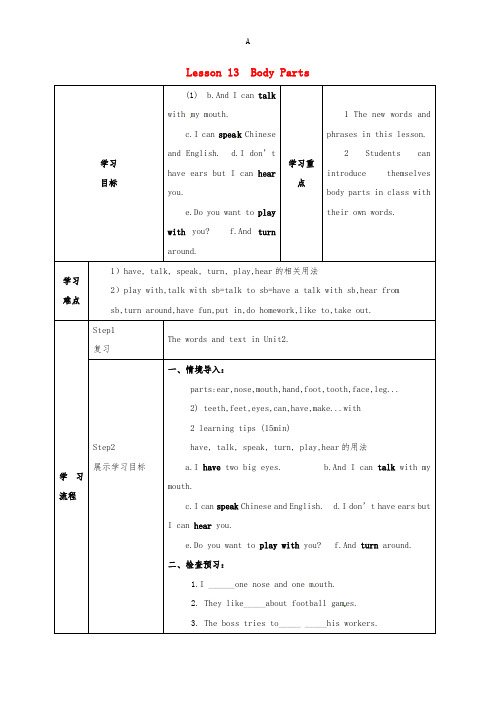
Lesson 13 Body Parts学习目标(1) b.And I can talkwith my mouth.c.I can spea k Chineseand English. d.I don’thave ears but I can hearyou.e.Do you want to playwith you? f.And turnaround.学习重点1 The new words andphrases in this lesson.2 Students canintroduce themselvesbody parts in class withtheir own words.学习难点1)have, talk, speak, turn, play,hear的相关用法2)play with,talk with sb=talk to sb=have a talk with sb,hear from sb,turn around,have fun,put in,do homework,like to,take out.学习流程Step1复习The words and text in Unit2.Step2展示学习目标一、情境导入:parts:ear,nose,mouth,hand,foot,tooth,face,leg...2) teeth,feet,eyes,can,have,make...with2 learning tips (15min)have, talk, speak, turn, play,hear的用法a.I have two big eyes.b.And I can talk with mymouth.c.I can speak Chinese and English.d.I don’t have ears butI can hear you.e.Do you want to play with you?f.And turn around.二、检查预习:1.I ______one nose and one m outh.2. They like_____about football gam es.3. The boss tries to_____ _____his workers.4.Do you_____Japanese? 5)Ple ase_____off the TV.6)I ____from my friend yesterday.三.自主学习:Listening (5min)1) Let students listen to the passage with the followingquestions in page34.a.What is the Robot’s name?b.What language do es theRobot speak?c.What does the Robot like?2) Listen and fill in the blanks in page 35.3) Listen and do th e actions.Step4当堂达标 Consolidations(15min)1) You have only one.You can smell with it.It’s a________2) You have t wo.You can work with them.They’re___________3) She____(have)a computer.4) Look at the pi cture and______about it.5) _____around,you may look this way.6) Turn____the TV,please,there i s a movie on it.Step5家庭作业Finish off the Ex x1,2,and 3 in the WB, L13. Prepare f or the next lesson.课后反思欢迎您的下载,资料仅供参考!。
- 1、下载文档前请自行甄别文档内容的完整性,平台不提供额外的编辑、内容补充、找答案等附加服务。
- 2、"仅部分预览"的文档,不可在线预览部分如存在完整性等问题,可反馈申请退款(可完整预览的文档不适用该条件!)。
- 3、如文档侵犯您的权益,请联系客服反馈,我们会尽快为您处理(人工客服工作时间:9:00-18:30)。
Unit 3 Body Parts and Feelings单元综合检测试题(45分钟 100分)第Ⅰ卷(共50分)Ⅰ. 听力(10分)(Ⅰ)录音中有五个句子,听一遍后,选择与之相符的图片。
(5分)(Ⅱ)录音中有一篇短文,听两遍后,选择最佳答案。
(5分)6. —Is Liu Hong’s friend a boy or a girl?—A ________.A. boyB. girlC. teacher7. —Where is Ann from?—She is from ________.A. ChinaB. CanadaC. England8. —Is Ann’s hair long?—________.A. Yes, it isB. No, it isn’tC. Yes, it isn’t9. —What does Ann wear?—She wears ________.A. shortsB. a hatC. glasses10. —What’s the matter with Ann?—She cut her ________.A. toeB. fingerC. armⅡ. 单项选择(20分)1. —May I help you?—Yes. I want ________ a shirt.A. buyB. to buyC. buysD. buying2. Let’s ________ the movie theatre ________ a movie.A. go; watchB. to go; watchC. go to; watch toD. go to; to watch3. The girl is Sue. ________ is a good girl. I’m ________ sister.A. He; hisB. She; sheC. Her; sheD. She; her4. My friend Jerry has ________. They are in his desk.A. a good bookB. two black chairsC. blue four erasersD. three purple pencils5. Jenny is my friend. Danny is my friend, ________.A. toB. tooC. twoD. or6. —Do you write ________ markers?—No, I don’t.A. onB. fromC. withD. in7. —________?—He is 1. 5 metres tall.A. How tall is heB. How old is heC. How tall does heD. How old does he8. —Does Li Lei have a bike?—Yes, ________.A. he does oneB. he have oneC. he doesD. he do9. My brother ________ a new bag, but I ________.A. has; don’tB. have; doesn’tC. doesn’t has; doD. don’t have; does10. I’m short, ________ my sister is tall.A. andB. soC. butD. orⅢ. 完形填空(10分)Dick is not old, 1 he doesn’t have 2 hair. His wife Alice has black, thick(厚) and beautiful hair. They 3 one daughter. 4 name is Jane. She is four and a half years old.There is a picture 5 Dick in the living room. Jane often looks at it 6 and then says to her mother, “Mummy, why has Daddy got(有) very little hair?”Alice laughs and says, “He’s got very little hair because he 7 a lot. Jane, he’s a clever(聪明) man. ”Jane 8 her mother’s thick, black hair 9 a few seconds, and then she asks, “Mummy, why have you got 10 hair”?1. A. and B. then C. but D. so2. A. many B. much C. few D. a few3. A. has B. have C. are D. is4. A. His B. Her C. Whose D. Hers5. A. for B. with C. of D. to6. A. long a time B. for a long timeC. long timeD. for the long time7. A. to think B. are thinkingC. thoughtsD. thinks8. A. looks for B. looks upC. looks atD. looks out of9. A. in B. forC. atD. of10. A. a lot of B. a lotC. manyD. very littleⅣ. 阅读理解(10分)It has a large body. It has long legs and small feet. It has green eyes and a short nose. It has yellow fur(毛) and big ears. It has a long thin(细的) neck(脖子). It has a big mouth and sharp(尖的), white teeth. It’s eating(吃) a green plant.1. How many legs does it have?A. Four.B. Three.C. Two.D. We don’t know.2. What colour are its eyes?A. Yellow.B. Green.C. White.D. Red.3. Are its ears small?A. Yes, they are.B. Yes, they are small.C. No, they are small.D. No, they are big.4. How tall is it?A. We don’t know.B. It’s 2. 1 metres tallC. It’s 3. 1 metres tall.D. It’s 1. 2 metres tall.5. What’s it eating?A. Green plants.B. A green plant.C. A tree.D. White plants.第Ⅱ卷(共50分)Ⅴ. 词汇运用(10分)(Ⅰ)根据句意及首字母或汉语提示完成单词。
(5分)1. John is tall. Tom is short. They look d________.2. My brother likes to l________ to music very much.3. The singer often wears a pair of ________ (有趣的;滑稽的) glasses.4. I want the same ________ (照相机) as you have.5. The boy has a________ (头痛) and needs to see a doctor.(Ⅱ)从方框中选词并用其适当形式填空。
(5分)hair, play, have, look like, be6. —What does she________?—Good-looking.7. The girl with big eyes ________ Sally.8. She has long beautiful black ________.9. Zhang Hua is the best ________ in our school.10. Li Lei ________ a pair of new pants.Ⅵ. 完成句子(10分)1. 我和珍妮、露西来自加拿大。
Jenny, Lucy and I ________ ________ Canada.2. ——你怎么了?——我把一个手指弄伤了。
—________ ________ with you?—I cut a finger.3. ——李明的姐姐长什么样?——她又高又瘦。
—________ ________ Li Ming’s sister ________ ________? —She is ________ and thin.4. 我的同学有五根白头发。
My classmate has ________ ________ ________.5. 你最好待在家,好好休息。
________ ________ ________ ________and have a good rest. Ⅶ. 补全对话(5分)从方框中选择最佳选项完成对话,有两项多余A. Thank you.B. May I have two, please?C. Do you feel happy, Li Lei?D. You are welcome.E. Me, too.F. No, I’m not.G. I have four.Wei Hua: Hi, Li Lei!Li Lei: Hi, Wei Hua!Wei Hua: How many markers do you have?Li Lei: 1Wei Hua: 2Li Lei: Sure. Here you are.Wei Hua: Thanks, Li Lei.Li Lei: 3Wei Hua: 4Li Lei: Yes, I am very happy. How do you feel?Wei Hua: 51. ________2. ________3. ________4. ________5. ________Ⅷ. 短文填空(10分)从方框中选词并用其适当形式填空,使短文完整、通顺come, give, have, happy, play withMrs. Black is an old English woman. She likes cats(猫). She 1 many cats at home. The students all like 2 to her home. They like 3 her cats. So she 4 the students her cats. The students are happy. She is very happy. And the cats are 5 , too.1. _______2. _______3. _______4. _______5. _______Ⅸ. 书面表达(15分)请你以“My body”为题写一篇短文。
